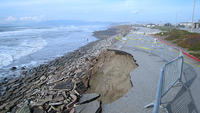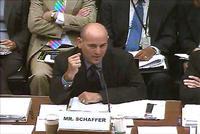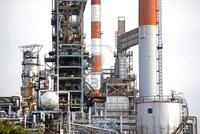-
Sensor network to provide early quake alerts
Researchers from U.S. universities are collaborating to implement a new network of seismic sensors aimed at arming communities with early earthquake detection and warning capabilities; the sensors, no bigger than a Post-it note, are part of a new phase of the Quake-Catcher Network (QCN), a project gathering detailed data to help scientists understand the earthquake process and how to mitigate against its effects
-
-
Bill to allow DHS to seize authority over U.S. coastlines
The House is currently considering a bill that would cede control of America’s coastlines to DHS; under the proposed National Security and Federal Lands Protection Act, the Secretary of the Interior would forfeit authority of all public coast lands to the Secretary of Homeland Security, whenever the DHS chief sees fit
-
-
Melting ice sheets chief cause of rising sea levels
There are two causes for rising sea levels — melting ice sheets and thermal expansion of warming ocean waters; during the Last Interglacial Period, the former contributed much more to rising sea levels than the latter, a University of Arizona-led team of researchers has found; the results further suggest that ocean levels continue to rise long after warming of the atmosphere levels off
-
-
U.S. West Coast is rapidly eroding, with pace to accelerate

The stormy conditions of the 2009-10 El Nino winter eroded beaches from San Diego to Seattle to often unprecedented levels; the higher sea levels expected due to global warming, and potentially even stronger winter storms, will likely to contribute to increased rates of beach and bluff erosion along much of the U.S. West Coast
-
-
Preparing for the worst
Nearly three quarters (73 percent) of companies surveyed by AT&T are calling business continuity a priority in 2011, and almost half of them are seriously thinking about using cloud technology to help them deal with terrorism threats, security breaches, the problems that come when the power goes out or the weather turns extreme
-
-
Malware imported into U.S. on foreign-made components

A high level DHS official acknowledged that malware built into imported electronic components sold in the United States poses a serious threat to U.S. economy and security; he also said it was a complex threat which the federal government has been trying to address in different ways; Greg Schaffer, acting deputy undersecretary for the National Protection and Programs Directorate at DHS, said the threat is “one of the most complicated and difficult challenges we have”
-
-
Securing critical infrastructure: portfolio based approach
Bryan Ware, the CEO and co-founder of Digital Sandbox, a firm that provides risk analysis and management software and services to the private and public sectors, was recently interviewed by Homeland Security NewsWire’s executive editor Eugene Chow; Ware discusses a portfolio based approach to securing critical infrastructure, what the government can do better to protect critical assets, and the dangers of taking a “Whack-a-Mole” tactic with national security threats
-
-
Volunteers help California build quake sensor network
Thousands of residents across California are helping the U.S Geological Survey (USGS) build a dense network of seismic sensors across the state; as part of the Quake Catcher Network, Californians are being asked to place 6,000 seismic sensors in their homes to help geologists study earthquakes
-
-
Sector Report for Monday, 11 July 2011: Infrastructure protection
This report contains the following stories.
Plus 1 additional story.
-
-
Fire retardant shows promise -- if given space
Scientists have demonstrated that the more widely and uniformly dispersed nanoscale plates of clay are in a polymer, the more fire protection the nanocomposite material provides; when polymer — a type of polystyrene, used in packaging, insulation, plastic cutlery, and many other products — is imbued with nanometer scale plates of montmorillonite, the combination can create a material with unique properties or properties superior to those achievable by each component — clay or polymer — on its own
-
-
Quake-resistant superelastic alloy developed
Japanese scientists added a small amount of nickel to an iron-based alloy, and found that the new material can recover its original shape at any temperature from -196 to 240 degrees Celsius; the material may be used in environments that are constantly exposed to extreme temperatures, such as joints and controls in cars, planes, and spacecraft; it may also help buildings cushion stress and violent movement in earthquakes
-
-
Senate committee passes chemical security bill

This week, the Senate Committee on Homeland Security and Governmental Affairs voted 8-2 for Senator Susan Collins’s bill (S. 473) to renew the Chemical Facility Anti-Terrorism Standards (CFATS), which is designed to regulate the chemical industry to ensure that they are keeping their facilities safe from terrorist attack; a similar bill has already been approved by a House committee; so far DHS has reviewed 39,000 chemical facilities in the United States and has determined that more than 4,755 are high risk and need to develop detailed security plans
-
-
Sharp divisions over chemical plant security measure
Those who opposed the original Chemical Facility Anti-Terrorism Standards (CFATS) continue to oppose it — and for the very same reasons: they argue it does not go far enough to assure the security of chemical plants in the United States; they point out the versions of the bill approved by House and Senate committees prevent DHS from requiring specific security measures; fail to require safer and more secure chemical processes; exempts thousands of potentially high risk chemical and port facilities, including approximately 2,400 water treatment facilities and 400-600 port facilities, including 125 of 150 U.S. refineries; and prevents plant employees from participating in assessing vulnerabilities and developing security plans
-
-
Los Alamos nuclear waste safe from wildfire
A wildfire is raging near the Los Alamos national Lab; the fire, in some places, is only yards away from the lab’s outside perimeter — and it is eight miles from the so-called Area G; the Area G site is a 63-acre storage facility where thousands of drums of nuclear waste sit, many of which are outdoors started; the good news is that there is no danger that the fire will reach Area G because in 2000, an even more intense fire burned 90 percent of the forest that covered the area between the current fire and the nuclear waste disposal site, making it impossible for the current wild fire to reach the nuclear material on storage
-
-
Flights increase rain and snow near airports
Areas near commercial airports experience a measurable increase in rain and snow when aircraft take off and land under certain atmospheric conditions; when planes fly through certain mid-level clouds, they force nearby air rapidly to expand and cool; this causes water droplets to freeze to ice and then turn to snow as they fall toward the ground, often leaving behind odd-shaped gaps in the clouds
-
More headlines
The long view
Helping Strengthen America’s Critical Infrastructure
Everyday life depends on a robust infrastructure network that provides access to running water, communications technology and electricity, among other basic necessities. The experts who keep our national infrastructure secure and resilient also need a strong network to share their knowledge and train the next generation of professionals capable of solving complex infrastructure challenges.
AI and the Future of the U.S. Electric Grid
Despite its age, the U.S. electric grid remains one of the great workhorses of modern life. Whether it can maintain that performance over the next few years may determine how well the U.S. competes in an AI-driven world.
